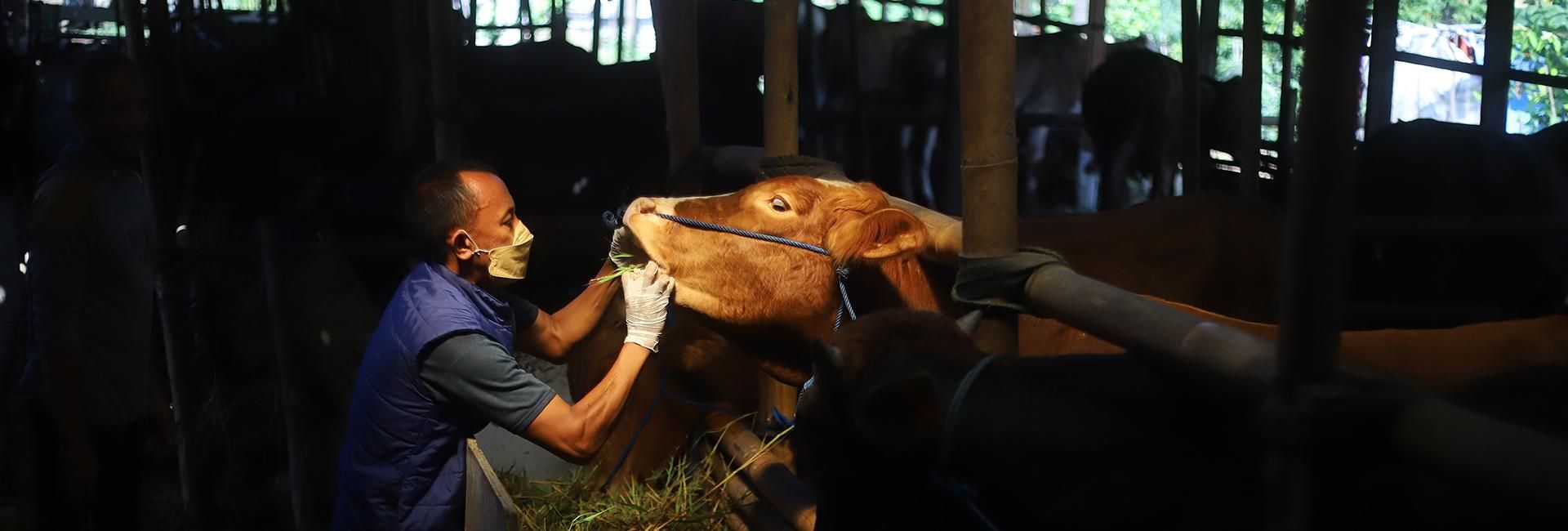Reynaldi is a 22-year-old construction worker (and small-time cattle farmer) in East Java. Like many in Indonesia, he keeps a small herd to supplement his income, raising four beef cattle in a shed he shares with a neighbour right behind his house.
This year, with Eid al-Adha — one of the largest Muslim holidays — approaching, his cattle began losing their appetite and struggled to eat. Mucus was dribbling from their mouths, their hooves became swollen and blister-like wounds appeared on their lower legs.
A few weeks earlier, the highly contagious foot and mouth disease had been detected in cattle 160 km north of his district. Now, just before he was due to sell his beasts for the Eid festival slaughter, the virus reached his small herd.
In the three months since foot and mouth disease was detected in Indonesia in May, it has spread like wildfire. There are presently 513,000 cloven-hoofed animals infected, with a further 362,000 recovered beasts. The government has allocated 180.7 billion rupiahs (A$17 million) to control the disease, but its slow initial response may mean the battle to eradicate the disease is a long one.
East Java, where Reynaldi breeds his cattle, is the largest meat-producing region in Indonesia, accounting for 32 per cent of the national cattle herd. With a population of more than 270 million, of which 87 per cent are Muslim, Indonesia slaughters and ritually sacrifices more than 1,5 million animals (cattle, goats, buffalo and sheep) every year. During the greater Eid celebration this July, farmers from East Java sent their cattle across the Indonesian archipelago to meet the festival demand for beef.
The virus could not have surfaced in East Java at a worse time.
Eid super-spreader
Denny Widaya Lukman, who works with Indonesia's Ministry of Agriculture, said the livestock movement from East Java to all parts of the country played an important role in the overwhelming growth in the number of cases.
Denny, a member of the Expert Committee for Animal Health, Veterinary Public Health and Animal Quarantine in the Ministry of Agriculture, said when infected animals migrate, areas within a radius of 10 km they pass through must be considered at risk.
“If the outbreak had not happened before Eid al-Adha, the condition may be would not have been as bad as it is now,” said Denny, whose expertise is in veterinary public health.
Even without direct contact, the foot and mouth virus can easily spread through air particles, with a morbidity rate of 100 per cent in naive cattle or swine herds. (A naive beast has zero immunity to the virus because it has never been exposed. The Australian herd would be similarly naive.)Initially, the government was in 'a panic state, perplexed in figuring out how to deal with it'.It is not the first time East Java has battled foot and mouth disease in its cattle herds. The first ever outbreak in Indonesia took place in 1887 and the virus became endemic in East Java. It would be more than 100 years before the country was declared FMD-free by the World Organisation for Animal Health in 1990 following a mass vaccination program.
In the three decades since, the government has not had to worry about the disease, and in its initial response to the current outbreak, the government was in "a panic state, perplexed in figuring out how to deal with it," Denny said.
"Indonesia already has an emergency preparedness plans for exotic diseases, including foot and mouth disease," Denny said. "But, because there are piles of documents, they just end up living in the closet for ages."
The plans, which have been revised five times since 2001, set out comprehensive measures across multiple government agencies. The outbreak was reported in May, yet, only towards the end of June did Indonesian President Joko Widodo establish a special task force for a more centralised response. The new unit now coordinates efforts on national data reporting, surveillance, testing, public communication and an education campaign for Indonesian farmers. Police and the army are also assigned for road patrols and restricting livestock movement in and out of the red zones.
Vaccinations are currently being rolled out for healthy dairy cattle in three phases. The government has imported 3 million vaccine doses from France, China, Brazil, and Argentina, but only 1.9 million animals had received a dose as of August 30.
Wiki Adisasmito, Expert Team Coordinator for the new special taskforce, told an online press conference that vaccination efforts were being hindered by the difficulty in reaching farmers in rural areas, a shortage of trained people to administer vaccines and maintaining doses at the correct temperature. There were also some reports of farmers choosing not to vaccinate their cattle because of doubts surrounding its efficiency and side effects.
The government has also set an optimistic target of 1 million doses to be produced locally, with 200,000 ready by September. Australia has pledged $1.5 million to fund at least 1 million doses in the vaccination program.
These numbers, however, are still very much below what the country needs to eradicate the disease. The Agriculture Ministry predicts Indonesia will need to secure at least 28.7 million doses by the end of this year.
Denny said the world vaccine supply for this highly contagious disease was initially very limited in comparison to other animal diseases. The government is also being very cautious in importing vaccines with a single O serotype so as not to introduce new or existing distinct variations that may have further unfavourable implications. Previously, a number of South-east Asian countries had to deal with a much more complicated vaccine formulation because multiple serotypes were identified.Too little compensation
The government plans to compensate farmers for livestock they are forced to slaughter, starting from 1.5 million rupiahs (A$145) for goats, sheep and pigs, up to 10 million rupiahs (A$960) for cattle.
More than 90 per cent of beef cattle production in Indonesia comes from small-scale farmers with only two to three cattle per household, just like Reynaldi. Although secondary to their main occupation, raising cattle is as an important livelihood asset which can be cashed in as needed.
Many farmers say the government’s compensation or assistance aid is too low.
Farmers can still sell their cattle on the open market. Prior to the outbreak, a mature Limousine cow usually cost 17-20 million rupiahs (A$1,600-$1,900) but prices have now fallen to as low as 2-10 million rupiahs (A$190-$960) depending on the beast’s condition. Reynaldi has chosen to keep his because of the significant price drop.
"I can't afford to sell my cattle at a loss," he said.
Threat to Australia
As the outbreak unfolds in Indonesia, Australian beef producers have monitored the response with concern.
Matt Dalgleish, an agricultural market analyst focussed on livestock, acknowledged that with the spread of FMD to at least 23 of Indonesia’s 37 provinces, including to Bali, there was a "slightly higher" risk to Australia. Upwards of 1 million Australians travel to Bali each year, and there is a danger they could bring back the virus on their shoes, clothing or the wheels of their suitcases. Having said that, he thinks the Australian government has done a great job in reinforcing the biosecurity measure so far.
"[The disease] has been around us for a while so our biosecurity at the border is designed to keep it out," Dalgleish said. "We should be able to still keep it out, so you don't have to be too kind of alarmist."
Response zones are now in place in airports, and travellers must comply with directions to remove their shoes or walk over sanitation mats. In order to pick up a higher range of meat products, all inbound parcels from Indonesia are also being scanned using x-ray machines. Australia's Agriculture Minister, Murray Watt, said it is the most robust biosecurity response any Australian government has ever imposed.
However, Stuart Austin, general manager of Wilmot Cattle, said these measures are still inadequate, given what the cost of eradicating the disease will be if it reaches Australia. The Australian Bureau of Agricultural and Resource Economics and Sciences estimates the country could lose a staggering $80 billion over 10 years due to significant international trade implications. If Australia’s FMD-free status is suspended, farmers will be left with no choice but to dump their livestock into a much smaller domestic market with possibly lower prices.
Rather than a ban on travel from Indonesia, which might be seen as an insult to one of Australia's most important bilateral partners, Stuart thinks there should be a mandatory luggage inspection for all incoming travellers at airports. Despite claims by Minister Watt of the “most robust biosecurity response ever”, recent reports show people are trying to evade Customs' screening, and there is little scrutiny to keep their actions in check.
"We're relying on people to be honest and tick the box that they've been on a farm," Stuart said. The reality is you don't actually have to be on a farm in Indonesia to come into contact with animals."
The eradication challenge
As with the Australia government’s claims around best practice biosecurity measures, the Indonesian government contends it has undertaken all necessary steps and is headed in the right direction for recovery. It claims the disease is now under control, and the outbreak will be eradicated altogether by the end of this year. The national reporting centre has shown a significant downtrend in new cases over the past few weeks. However, Nanang Purus Subendro, general chairperson of the Indonesian Cattle and Buffalo Breeders Association, told Tempo there was suspicion over validity of the data due to the poor self-reporting system and minimal oversight.
As the Indonesian government struggles to bring this new outbreak under control, it has highlighted the weaknesses in Indonesia’s disease control systems.
Foot and mouth disease has always been an ongoing threat to the country. Made up of 17,508 islands, with 95,181 kms of coastline, Indonesia has many illegal entry points for smuggling animals and animal products from FMD-infected countries. In its immediate South-east Asian neighbourhood, only Brunei Darussalam, Philippines and Singapore are declared free of the disease.
Despite this, the government seemed unprepared for a worst-case scenario: the lack of vaccine supply, poor coordination between government agencies and too few medical personnel tell the story. This basic unpreparedness could cost the country US$1.37 billion in annual economic losses.
On a macro level, this is bad news for Indonesia's national accounts. But more significantly, tens of thousands of small-scale cattle farmers like Reynaldi may be among the first to feel the pain, losing cattle that are often as valuable as their own house.





As a checkout chick, I'm used to rudeness. But I can't bear the threats and violence